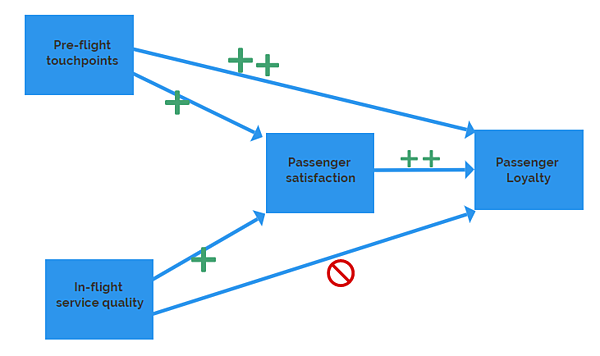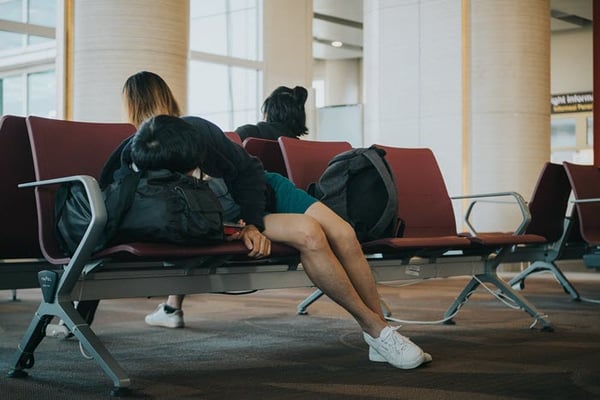Led by the team of Associate Professor Dr. Reza Etemad-Sajadi, this research aims to investigate direct and indirect effects of pre-flight and in-flight service quality on airline passenger satisfaction and loyalty.
In 2014, the airline industry transported 3.3 billion passengers and contributed US$2.4 trillion to economic activity (International Air Transport Association, 2014). In this context, airlines need to improve each touchpoint (before, during and after the flight) for their passengers. In this research, we focus on passenger perceptions of the quality of service experience, particularly those aspects over which the airline has direct control.
Airline service quality can be delineated as consumers’ overall impressions of the relative efficiency of an airline’s organization and services. The airline quality service involves the interaction between the airline’s passengers and its staff and therefore, the way a passenger is treated by an airline’s employee is an important consideration when assessing airline passenger perceived service quality. This research asserts that airline passenger perceived pre-flight and in-flight service quality are empirically distinct. Indeed, by distinguishing conceptually the two moments, we demonstrate that they have independent effects on passenger loyalty.
In addition to the services provided by the airline, which are under its direct control, the pre-flight experience involves services not provided by the airline and which are not under its direct control. For example, passengers’ perceptions of pre-flight service quality are influenced by departure airport tangibles (parking facilities), security check, and services (restaurant and shuttle services) over which the airline has no direct control. Moreover, airline tickets are often purchased through online (e.g., Expedia) or traditional travel agencies without any direct contact between the passenger and the airline.
An airline can provide customers with a variety of pre-flight services that would potentially enhance its passengers’ perceptions of pre-flight service quality. For instance, an airline can send its customers a text message or an email notification the day before their scheduled flight, when online check-in is available, or when their scheduled flight has been delayed/changed. With these services, airline passenger perceived pre-flight service quality is expected to be enhanced. Other strategies include efficient check-in and pre-flight processes and the way in which passengers are treated by the airline’s customer-facing employees during these processes. As for in-flight service quality strategies, the comfort in the aircraft and how passengers are treated by the airline’s in-flight crew are important considerations.
Our findings highlight the importance of an airline’s pre-flight service quality.
Indeed, airline passenger perceived pre-flight service quality was found to have a positive direct effect on passenger satisfaction and positive direct effects on airline passenger loyalty. In fact, pre-flight service was found to be much more important than in-flight service quality. Airlines are not often directly responsible for delays (e.g. bad weather) or other failures resulting from services provided by airport personnel. Nevertheless, this study’s findings indicate that airlines can enhance their passengers’ perceptions of service quality by focusing on those aspects of the pre-flight service experience over which they have direct control.
In addition, airlines can implement customer journey mapping to better understand the feelings of their passengers and implement appropriate service solutions. For instance, long queues, staffing shortages, or other inconveniences can negatively influence passengers’ pre-flight (check-in) and in-flight service experience. Through customer journey mapping, an airline is able to identify the needs of different groups of passengers (e.g., passengers with children and business passengers) at various touchpoints (check-in) and implement appropriate service solutions. The pre-flight stage may also influence in-flight comfort and stress. Indeed, the in-flight experience can be enhanced by airline check-in employees soliciting passengers’ in-flight preferences (e.g., seat location) and providing passengers with relevant flight information (e.g., duration of flight). Thus, airlines should ensure that they have employed human resource systems and management practices/processes that elicit such positive service-oriented behaviors from their check-in employees.

How can the passenger experience be improved?
After a long day of travelling, a passenger is often left with the exhausting aftermath of jetlag. Drinking caffeinated drinks or staying well-hydrated are popular ways adopted by passengers to counter the effects of the problem. However, Airbus made a major breakthrough: the new aircrafts can be installed with LED lights and air control systems that help mitigate the effects of jetlag, simulating sunrise and sunset. Passengers arrive at their destinations feeling “refreshed and ready to go”. Offering such a service would definitely increase the in-flight service quality as perceived by passengers. Other in-flight services range from aircrafts with a particular scent (Virgin Atlantic Airways) to serving fresh vegetables as snacks (Qantas Airways) or in-flight yoga and meditation sessions (Cathay Pacific Airways).

Airbus proposes a system that reduces passengers’ jetlag
Not being jetlagged seems like a dream; but before that, the aircraft has to take off! Although delayed flights are not always the airline’s fault, there are some approaches that can make the passenger’s situation better and could be offered as a premium guarantee service. If the airline knows beforehand that the flight will be delayed, they can send a text message or an email to passengers to inform them of the situation. In this case, it would be ideal if the airline could reduce passengers’ wait time. We have all had, at one point or another, to cope with a delayed flight…and the hardest part is sitting in uncomfortable chairs, for hours on end. As previously mentioned, a premium guarantee service could therefore be offered to clients, where they could wait in a lounge in which relaxation is enhanced. Other services could include a free drink or snack, or an activity in which passengers could participate.

Singapore Changi Airport Lounge
In the current climate situation, another aspect to consider is offering clients the opportunity to offset their carbon footprint. Some companies, such as myclimate already offer to fund international projects and sustainable development initiatives worldwide as a way to combat pollution. According to Myclimate, in order to halt climate change, the maximum amount of CO2 a person should produce a year is 0.6t of CO2. However, on average, a citizen of the EU produces 8.4t of CO2 each year. To illustrate these numbers, a single flight from Geneva to Seoul produces 1.7t of CO2 per passenger! An airline could propose to offset its clients’ carbon footprint, whereby it would contribute to the costs of climate protection projects.
Access the full study:
Full Professor at EHL Hospitality Business School





